New research reveals how air pollution disrupts bee gut microbiomes
Published in Earth & Environment, Microbiology, and Genetics & Genomics

Bees play a critical role in our ecosystem diversity and global food supply, but what if something as invisible as air pollution is putting their health at risk? Recent declines in bee populations have put a spotlight on understanding what factors might be driving these changes. So far, bee declines have been attributed to: habitat loss, pesticide use, the spread of bee diseases and climate change. Research into bee health and environmental factors can inform efforts to help preserve bee populations. Our research explores the impact of air pollution on bees and their beneficial gut microbes.
The bee gut microbiome
A key component of bee health is their specialized, beneficial gut microbial community. We know that healthy bees play host to a multitude of microbes that form a community of bacteria in their gut: the gut microbiome. After hatching bees establish their gut microbiome over the course of a few days from interactions with other bees in their colony, and from the colony environment. This means that bees from the same colony share their gut bacteria with each other – just as humans living in the same household also have similar microbiomes! Once bees reach adulthood the make-up of their mature gut microbiome remains relatively stable, unless it is disturbed by an external factor such as antibiotics.
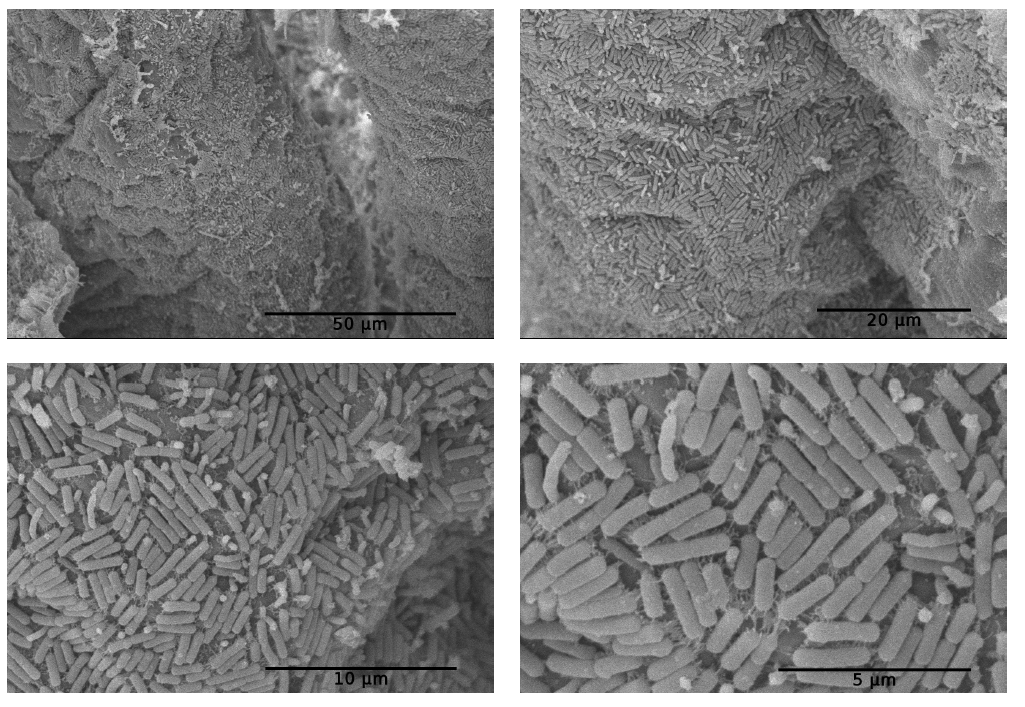
Images of the bee gut microbiome showing highly organised and connected bacteria in the bumblebee’s large intestine. Images are of the same section at increasing magnifications (taken by Hannah Sampson, using the Electron Microscopy Facility, University of Leicester).
A ‘good’ gut microbiome benefits bee health, helping to break down food and can protect against disease causing ‘bad’ bacteria. Disruption to the natural balance of the ‘good’ bacteria in a bee’s gut can have negative health effects - food isn’t broken down as efficiently meaning less available nutrients and, even worse, rates of infection and mortality increase. Understanding more about what things can change the bee gut microbiome, and how, can help shed light on what could be causing their population decline.
The role of air pollution
Air pollution is the world’s greatest environmental health risk, with many areas exceeding the World Health Organisation’s air quality guidelines. Pollutants come from a variety of sources, including motor vehicles, urbanisation, industry and combustion. Particulate matter, the solid component of air pollution made up of microscopic particles, is toxic and responsible for increasing the prevalence of human respiratory disease and impacts our global ecosystems. We believe that, like humans, insects are also being affected by air pollution, which could be contributing to pollinator decline.
Recently, research has discovered that bees interact with air pollution particles. As bees fly and forage for food, microscopic pollution particles are inadvertently collected on bee’s hairy bodies. When bees return from foraging, they carry the particulate matter back, exposing the colony via consumption and inhalation.
The Morrissey group was the first to identify the impact of particulate matter on bacteria, finding that particulate matter changes the behaviour of disease-causing bacteria in humans, increasing potential for infectious disease. Thus, air pollution could have unexplored impacts on other microbial life - such as the microbes important for bee health. In this study we explored the impact of air pollution particulate matter on the bee gut microbiome.
To investigate this area of study, we asked two key questions:
1) Does particulate matter air pollution change the behaviour of beneficial bee gut bacteria?
2) Does exposure to particulate matter air pollution disrupt the bumblebee gut microbiome?
1) Does particulate matter air pollution change the behaviour of beneficial bee gut bacteria?
Key beneficial bee gut bacteria, Snodgrassella, is a pioneering species of gut colonisers, important for breaking down food into usable nutrients. Snodgrassella colonises the bee gut in a complex biofilm structure, binding to the surface of the large intestine.
To study how Snodgrassella biofilms form, and how they might be affected by black carbon, a type of particulate matter, I tested Snodgrassella biofilms at multiple different times. I found that black carbon exposure increased Snodgrassella biofilm formation at the early timepoints up to 24 hours, changing the biofilm colonisation behaviour of this important bee gut bacteria.
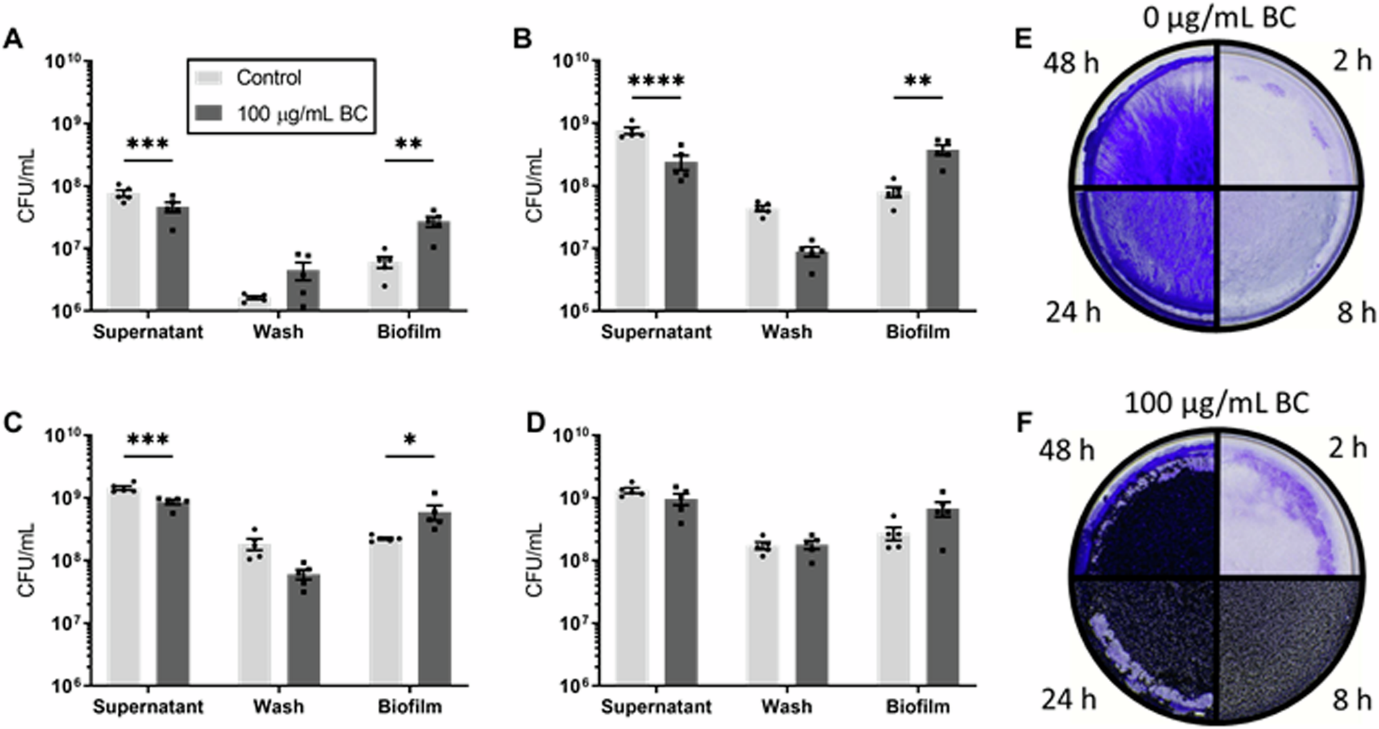
The effect of black carbon particulate pollution on Snodgrassella biofilms at different timepoints. Snodgrassella biofilm growth at timepoints: A) 2 hours, B) 8 hours, C) 24 hours and D) 48 hours and images of stained biofilms at different timepoints E) control and F) black carbon exposed.
We investigated this phenomenon further, analysing gene transcription in black carbon treated Snodgrassella biofilms and imaging the biofilms using scanning electron microscopy. We observed that biofilms grown in the presence of black carbon showed larger protrusions jutting out from the surface, which was not observed in our particle control condition. Discovering that black carbon exposure changed the behaviour and biofilm formation of Snodgrassella, demonstrated that black carbon pollution has a direct effect on this key beneficial bee gut bacteria.
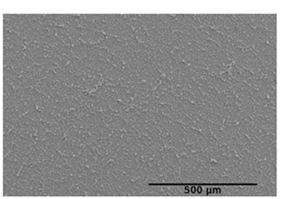
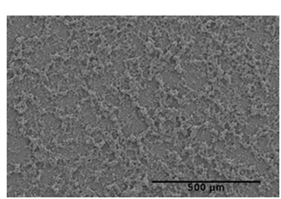
Scanning electron microscopy images of Snodgrassella biofilm protrusions: (left) no black carbon control, (right) black carbon particulate pollution treatment.
2) Does exposure to particulate matter air pollution disrupt the bumblebee gut microbiome?
To investigate the effect of black carbon particulate pollution on the bumblebee gut microbiome, I decided to study adult worker bees that had established their mature gut microbiome naturally within the colony. This is important because I wanted to test if black carbon pollution was able to disrupt a fully formed gut microbiome, as these mature communities are typically more robust and remain mostly stable for the rest of the bee’s life.
For the experiment, bees were randomly assigned to either the control group or treatment group and their microbiome was measured over time. To start, both groups were treated the same and their gut microbiome was measured at the ‘Pre’ timepoint. After which, the treatment group only were exposed to black carbon particulate pollution in their feed. At the end of the experiment the microbiome was measured again for both groups, the ‘Post’ timepoint.
To measure the gut microbiome, faecal samples were taken. Faecal samples were used, as while being less harmful and brilliantly non-invasive, also allow for multiple sampling of the same individual, perfect for longitudinal monitoring of the gut microbiome. I already know the question you have in mind, “How do you get a faecal sample from a bee?” Well, it is a very gentle and precise manoeuvre, to delicately coax a (sometimes very small) drop of bee faeces. It is, I’ll admit, a useful but very niche skill.
However, using bee faeces comes with drawbacks. Unlike dissecting whole bee guts, faeces contain much less bacteria, so working with bee faeces and sequencing them was a challenge to say the least. I optimised the methods to culture these bee faecal samples, and recorded how many bacteria had grown, finding that after bees were exposed to black carbon pollution there was significantly more bacteria growing.
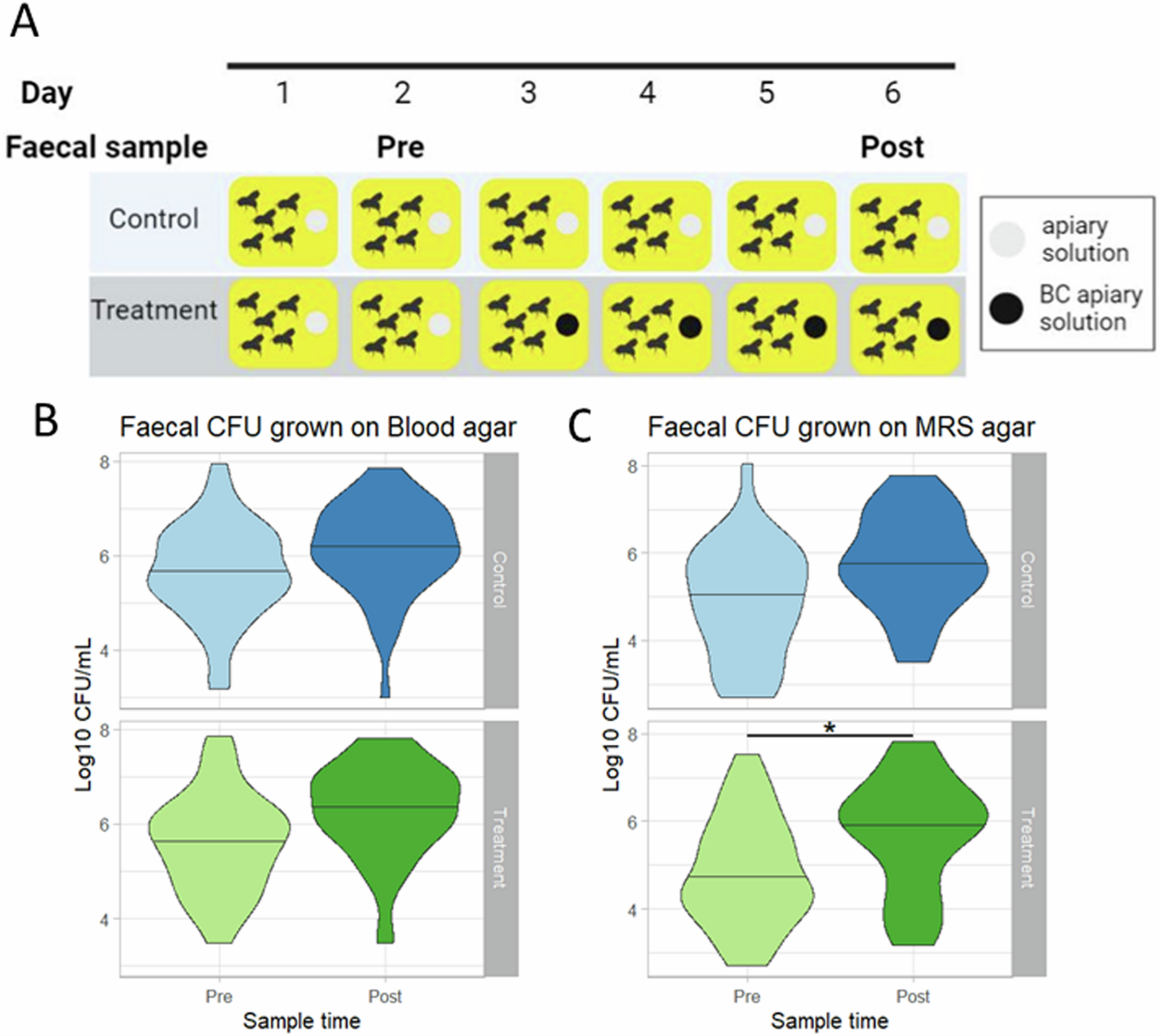
A) Experimental setup showing example experimental boxes, feeding patterns with apiary solution or black carbon (BC) apiary solution and sample collection across a daily period. Bumblebee faecal samples grown on blood agar (B) or MRS agar (C).
I developed methods to extract DNA and found that combining samples from each experimental box before extracting the DNA gave enough material to detect measurable amounts of bacteria. This step decreased my number of samples but maintained the study aim to compare gut microbiome paired samples before (‘Pre’) and after (‘Post’) treatment. Unfortunately, when sequenced, some of the paired samples did not give any results and had to be removed from the dataset, reducing our sample numbers.
We analysed the remaining paired samples, finding that after black carbon treatment, the gut microbiome composition was significantly different in the treatment group only, revealing disruption of the bumblebee gut microbiome. These findings demonstrate that black carbon exposure has direct, measurable effects on bees’ beneficial commensal bacteria and microbiome. Together these data highlight that particulate matter air pollution, is an underexplored risk to insect pollinator health and warrants further study. This research is just the beginning.
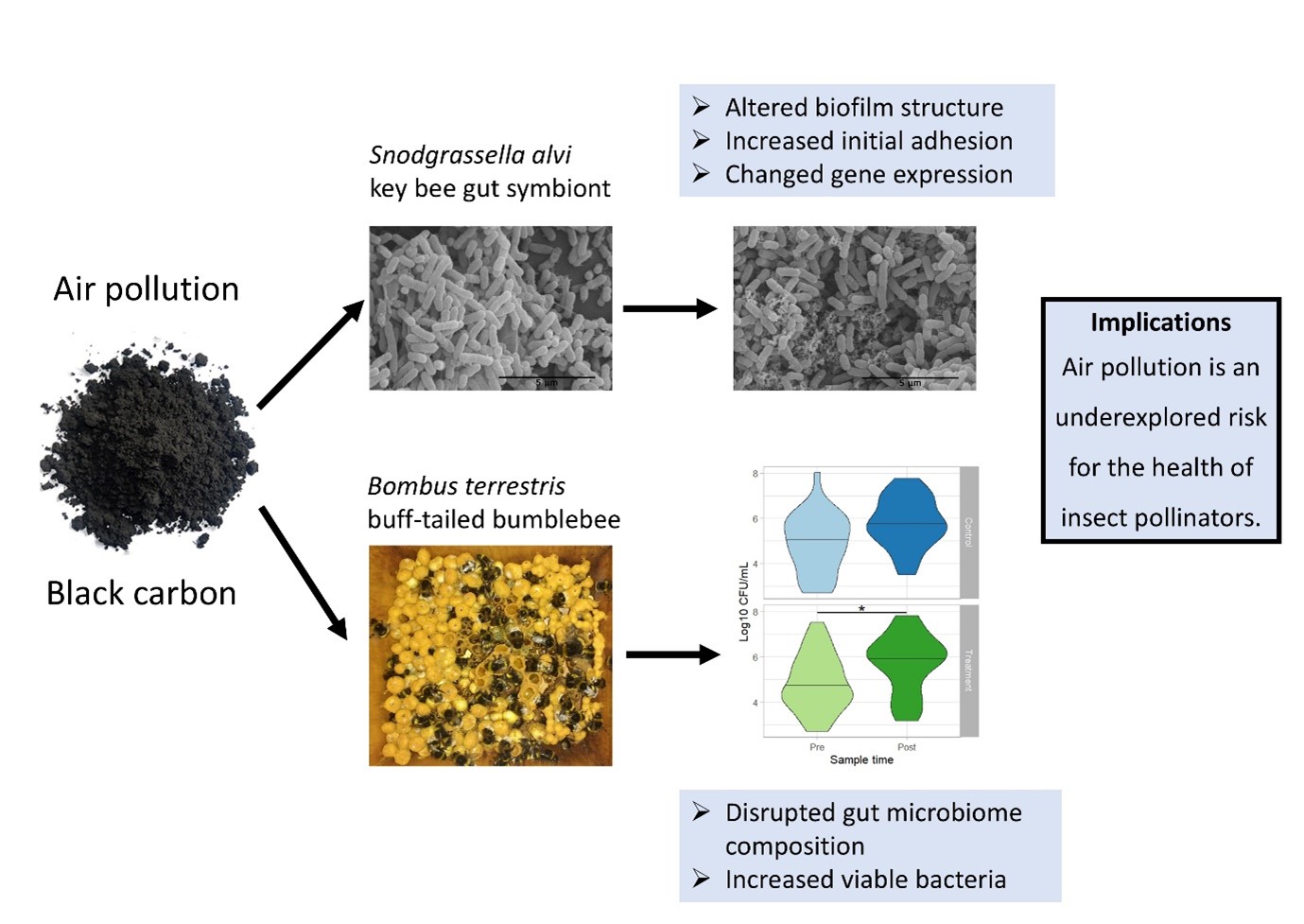
Parallel experimental investigations to study the impact of particulate air pollution on the bumblebee gut microbiome.
Research, much like microbes, is not isolated! I want to thank Prof. Morrissey, Prof. Ketley and Prof. Mallon and their research groups who have helped from the start to inform, shape and troubleshoot this intriguing yet sometimes trying project. I have learnt that research, while fascinating, can often feel slow at times and to empower you to trust the process and just keep at it, as through trial and error you might discover something unexpected! I am truly grateful to have had the opportunity to work on this important research and increase our knowledge in this field.
This post is probably the most you have ever read (or wanted to read) about bee faeces, and if not, please do check out the full manuscript published in npj Biofilms and Microbiomes.
Follow the Topic
-
npj Biofilms and Microbiomes

The aim of this journal is to serve as a comprehensive platform to promote biofilms and microbiomes research across a wide spectrum of scientific disciplines.
Related Collections
With Collections, you can get published faster and increase your visibility.
Microbial endocrinology
Publishing Model: Open Access
Deadline: Jan 21, 2026
Natural bioactives, Gut microbiome, and human metabolism
Publishing Model: Open Access
Deadline: Feb 20, 2026



Please sign in or register for FREE
If you are a registered user on Research Communities by Springer Nature, please sign in